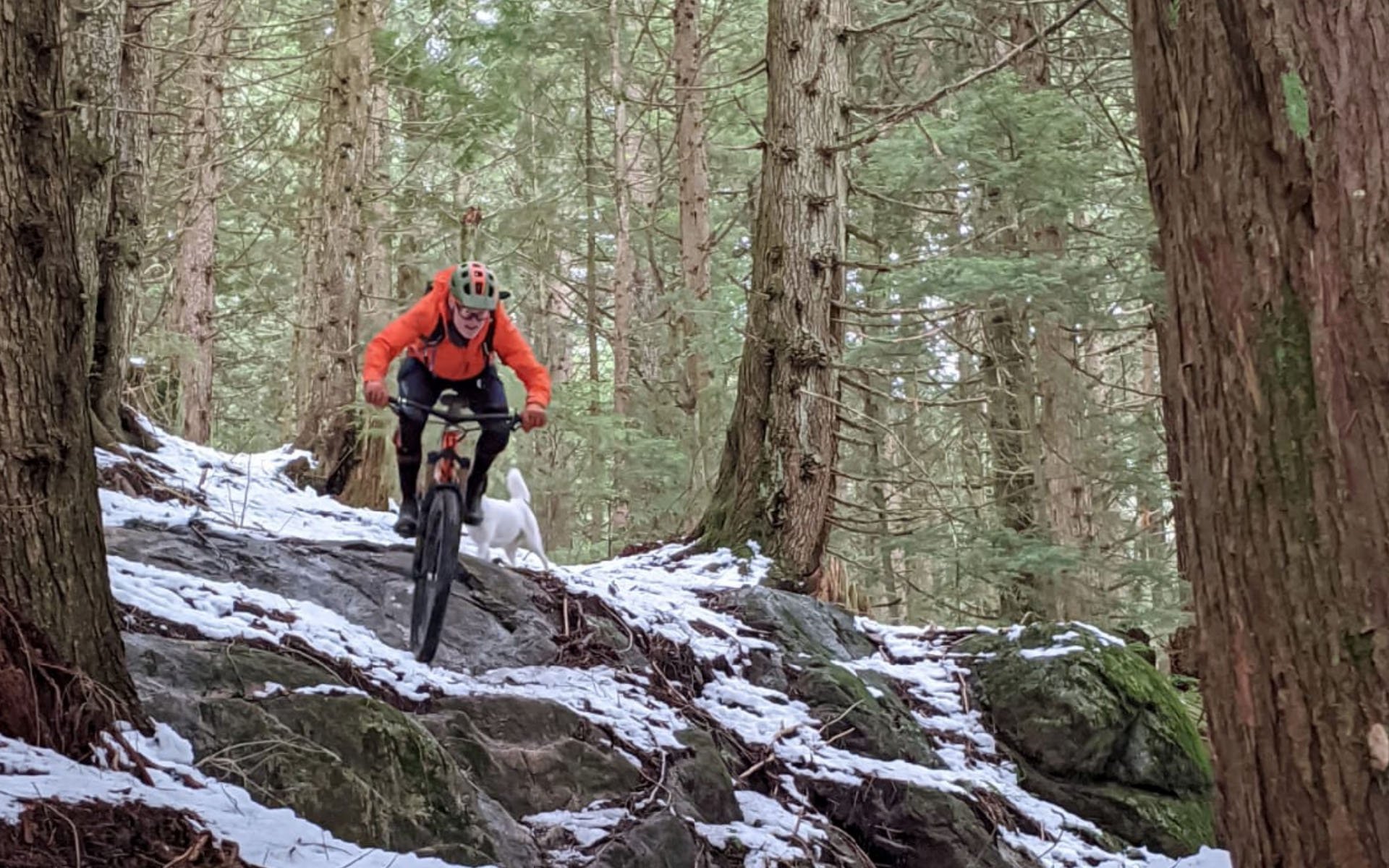
Editorial
What Makes a Tire Worthy of the North Shore?
I can be a reluctant tire tester. For the riding we do here on the North Shore, particularly in the rainy season between September and June, a tire needs to be close to perfect. Bad tires make you slow, tentative and terrified, rarely adjectives that describe a good ride. And certainly not a good tire review. Planning to ride a few of the nastier local trails on inferior rubber? It wouldn't be a bad idea to phone ahead for an appointment at the ER. You will be going down.
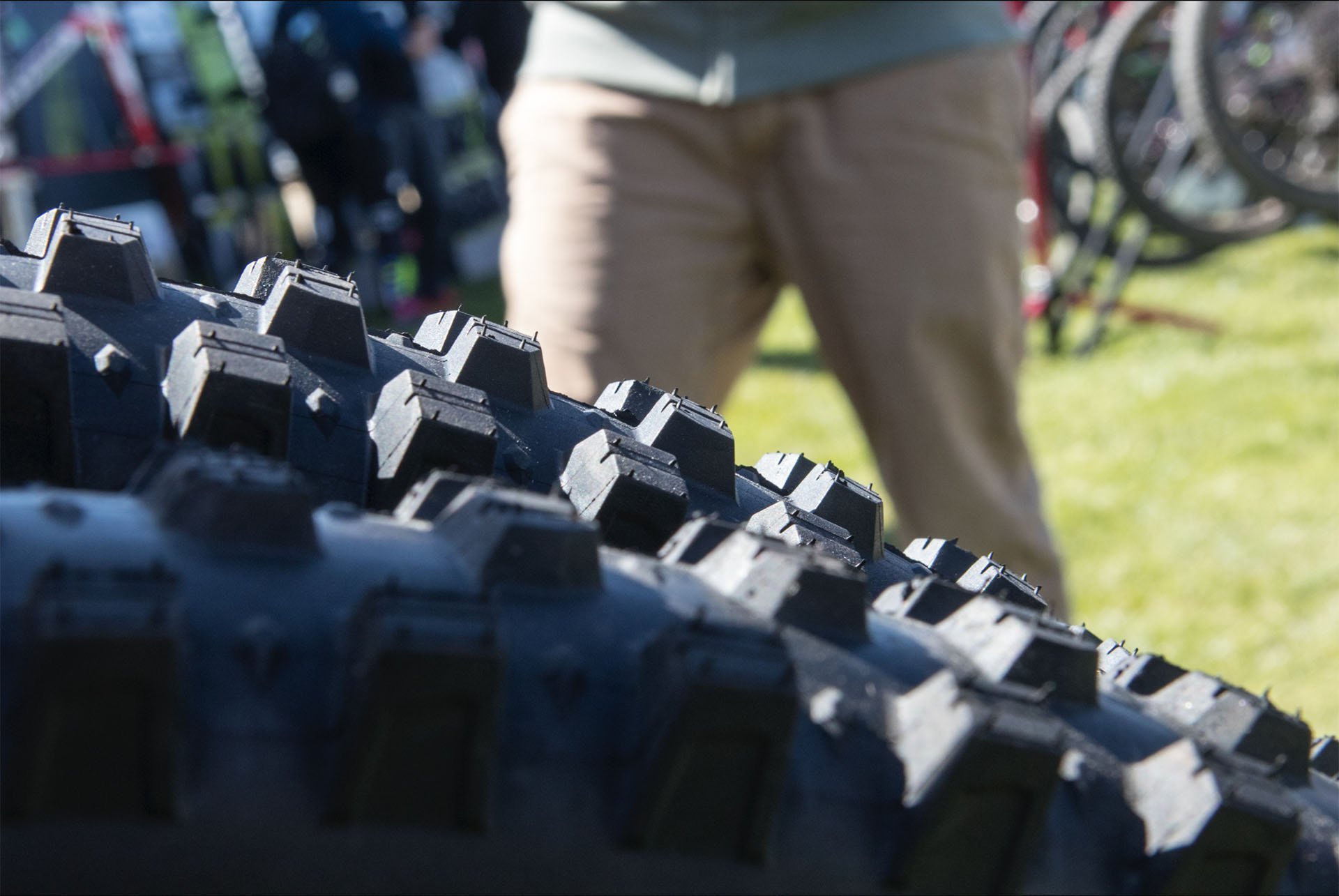
All the tall knobs. Photo - Cam McRae
The No-Compromise List
My list isn't long but it's very specific. The centre knobs have to be large and robust and well spaced for excellent grip braking bite and, to a lesser degree here,* mud shedding. The side knobs need to be well-supported to stick to off-camber roots and dig in for corners that are often steep and awkward. If the knobs are perfect but the compound is too hard, they might as well be slicks.
*North Shore mud is rarely sticky but tires can get gummed up anywhere
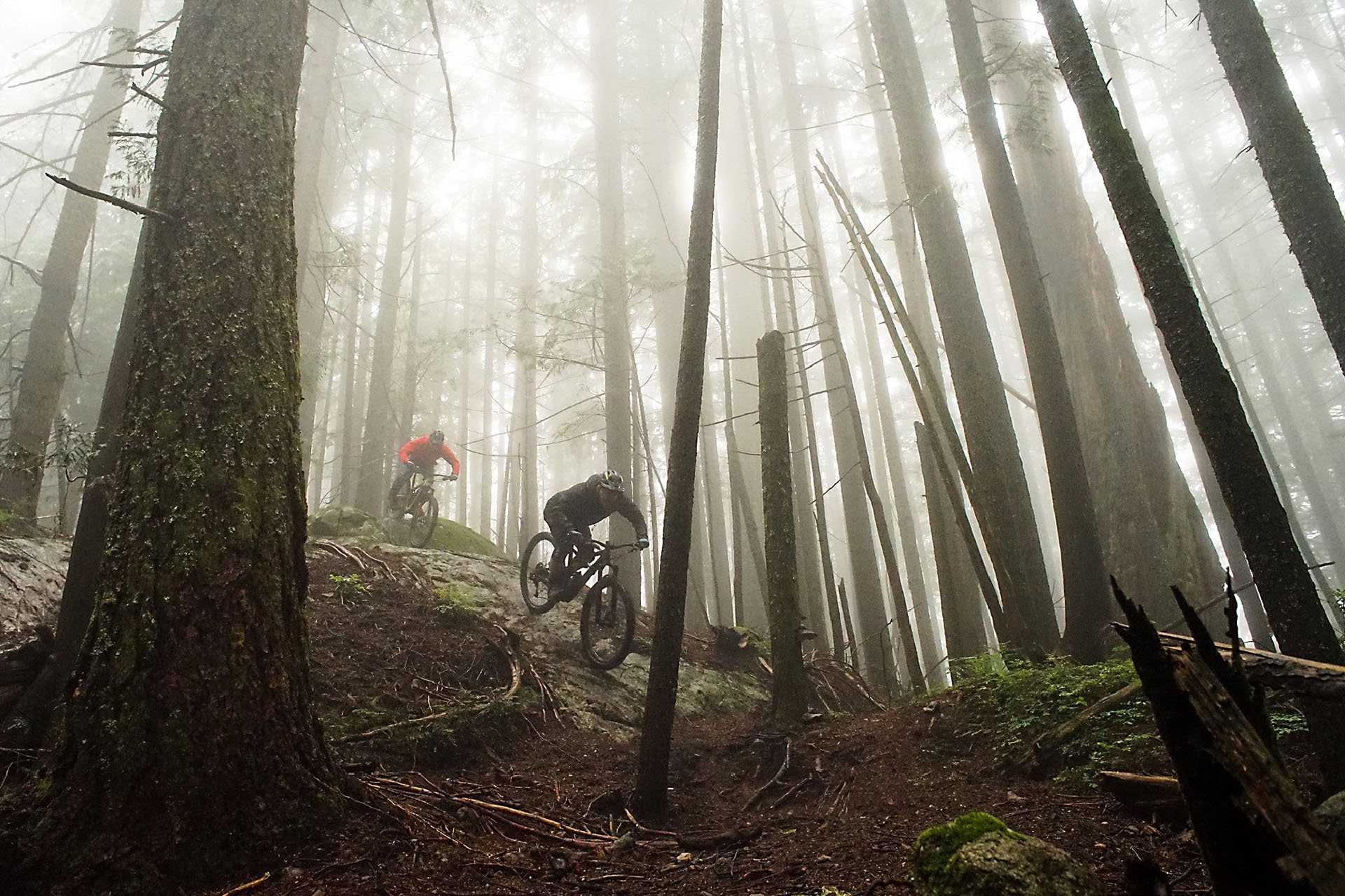
This photo was taken on July 5th, 2019. The sunburns were terrible.
Planning to ride a few of the nastier local trails on inferior rubber? It wouldn't be a bad idea to phone ahead for an appointment at the ER. You will be going down.
Soft compounds are even more important when temperatures are low, and 'cold and rainy' are the only adjectives you need to know about January this year, when it pissed or snowed 30 out of 31 days and almost broke the years old precipitation record. I think I rode 15 times but missed the one dry day. Riding on wooden features, planks, skinnies or ladder bridges is less common than it used to be, but it still happens on most rides. And even if there are no cedar stunts, plentiful shiny evil roots are guaranteed. Rock faces are abundant in some areas and many require a turn or course correction mid way. Our rocks have decent grip even in the wet, but they are also smooth and steep and sticky rubber allows vastly more control and braking bite. I prefer to ride soft compounds front and rear, but in a pinch front only works fine, and that will save you money.
Most of the factors described make tires work in the snow, and every descent in the last week has, at the very least, started on the white stuff.
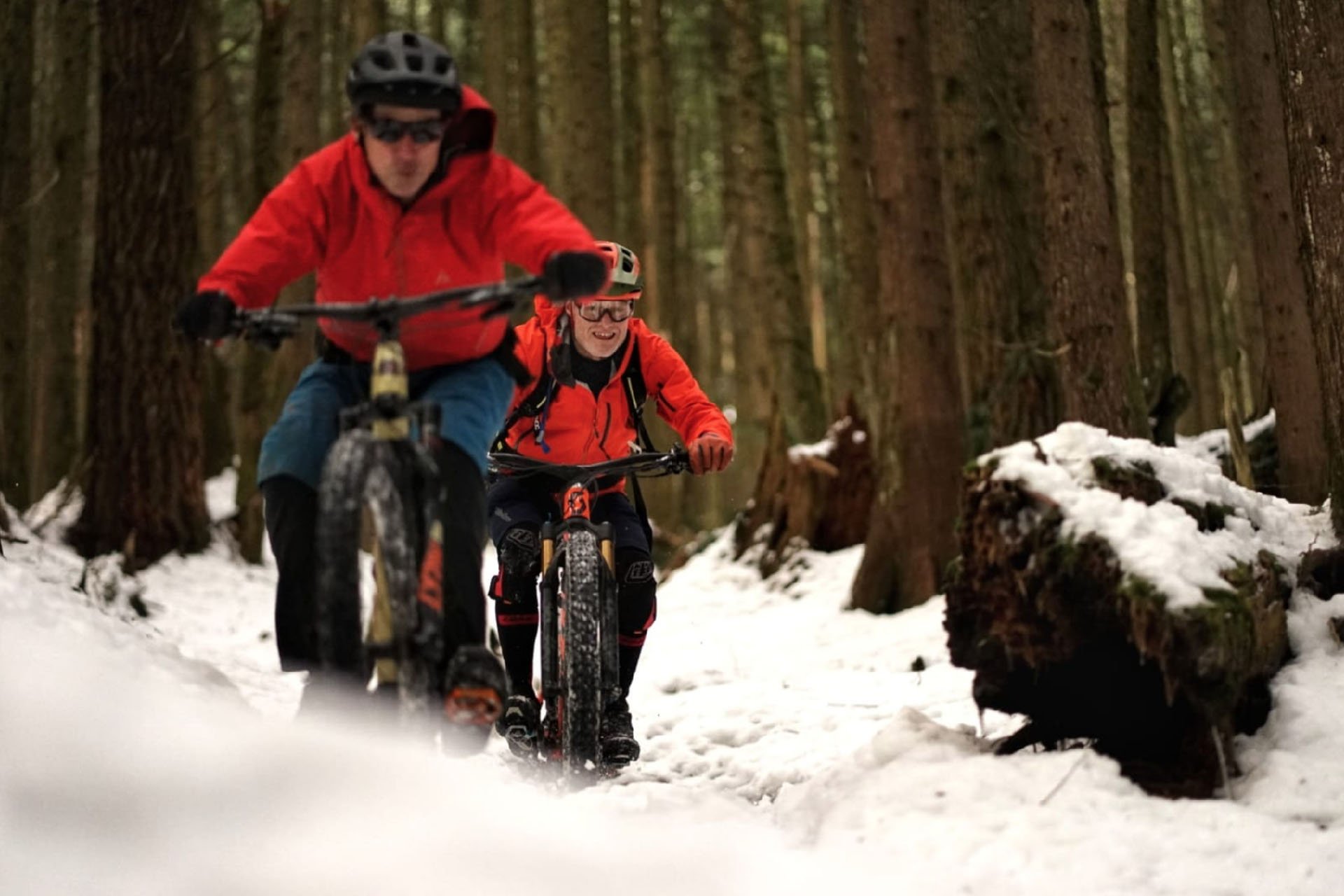
Hound Doggin' with James Wilson (right).
Many local riders, and this one in particular, prefer lower pressures to help tires do their work, which necessitates sidewalls that have generous support to avoid vague steering and handling and punctures. And because it's rocky and rough, the casing needs to be stout. More and more lately I'm enjoying higher volume rubber. My current sweet spots are 2.5" or 2.6" right now. And finally, because of the long steep climbs, they can't be too tubby.
Proviso
There are a couple of factors that create exceptions to these rules. Enough volume to allow significantly lower pressures make grip pattern and compound durometer less important. The same can be said even more emphatically for CushCore, and I've been perfectly happy on some incredibly crappy tires riding the inserts from Bend, OR. Low pressures are no problem for CushCore and the grip and support are truly remarkable.
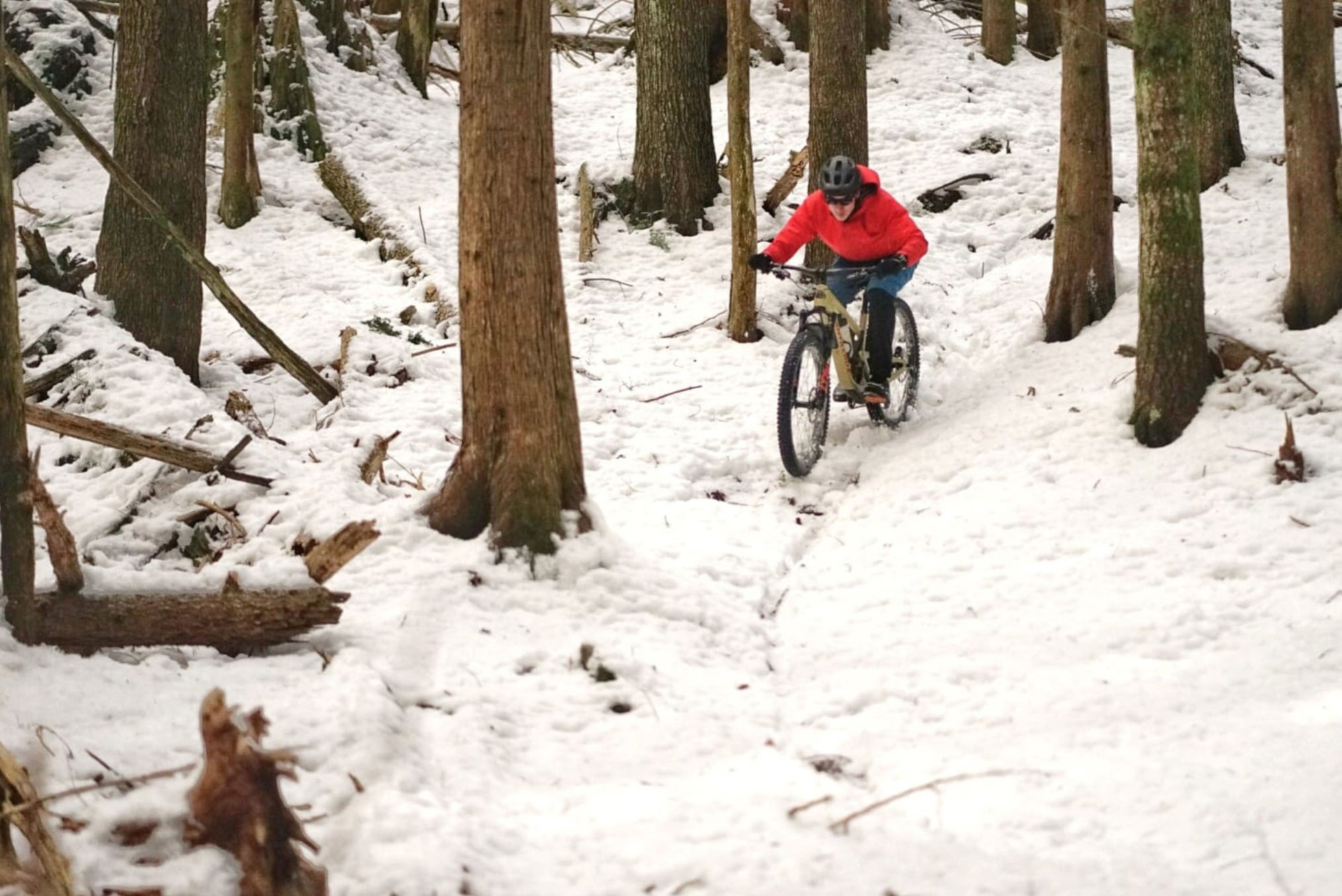
Snow conditions can be the sketchiest ever or the grippiest. The conditions above, which James Wilson described as 'styrofoam' were the latter.
What Works
It's a tough balance and I've rarely found tires to pass my fussy winter requirements. On my list are e*thirteen's MOPO tires (front and rear), Maxxis DHR II and Assegais with MAXX Grip rubber (front and rear for both), Schwalbe Magic Marys (front only) with Addix compound and... that's about it. It's often not possible to get the tire and casing and size I want even among those popular options. And to be clear, I'm sure there are other tires that could tick all my wet season riding boxes, but I haven't found them yet, potentially aside from a combo I'm not telling you about yet because I'll be publishing that review shortly.
To make myself perfectly clear, these are personal requirements. Other riders use higher pressures and don't need to be as fussy as I am about tire choice. But that's only because they are better than I am. I generally agree with my riding buddies on tread patterns and compound but sometimes we diverge on carcasses and widths.
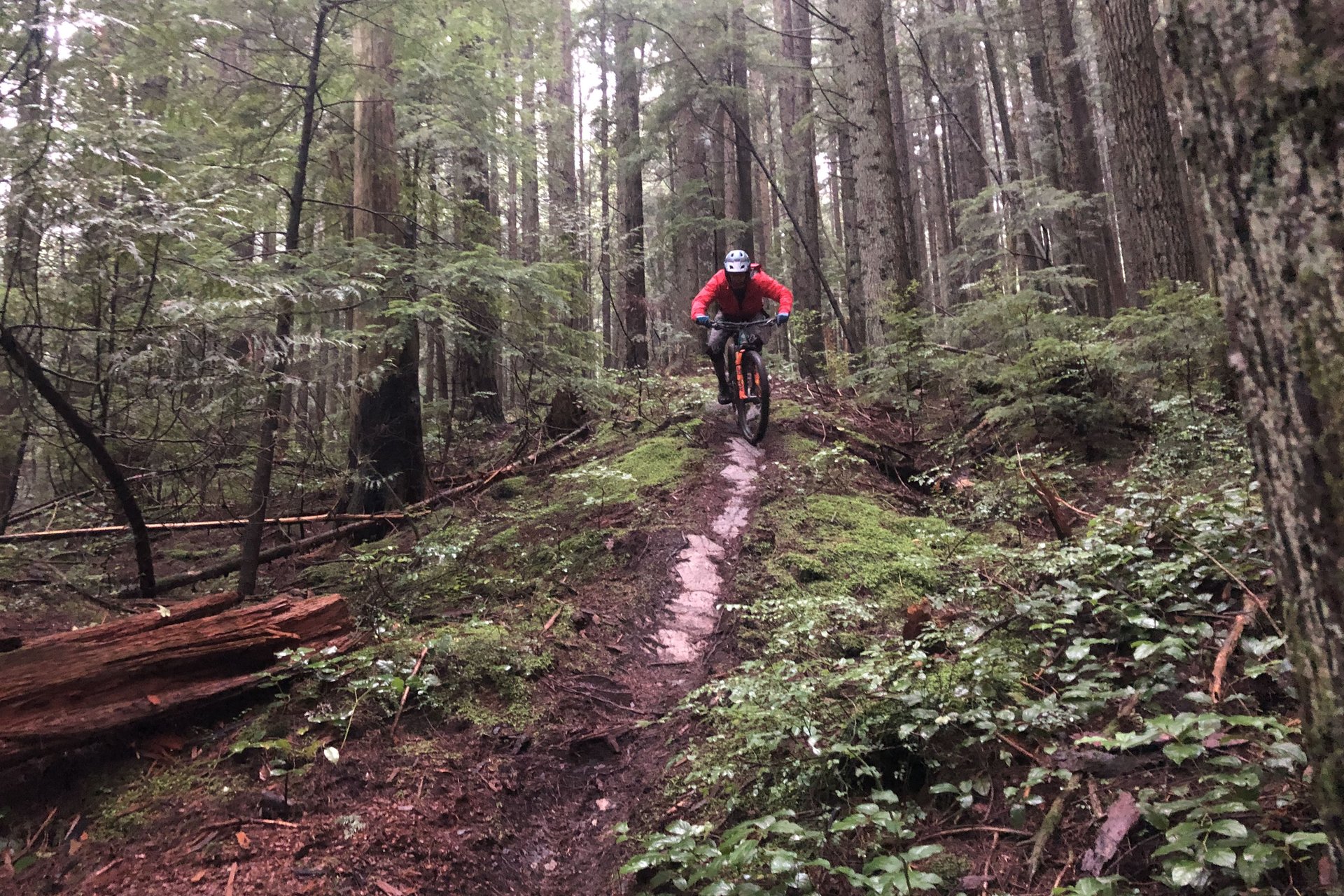
The cameras and phones stay pocketed when it's really nasty, but believe me it gets really nasty. Photo - Trevor Hansen
Often there are tires which excel here but fail in a few requirements that are less important for us. Loose over hard conditions, or loose in general, aren't common here but you'll experience both on most rides, and this is a bit of a crapshoot for me. I don't find DHR IIs or e*thirteens great in those conditions, but I don't have enough experience on Assegais or Magic Marys to render a verdict. Often these sorts of tires are challenged when lean angles get steep, because tall side knobs, which are great in off camber situations or less abrupt turns in soft conditions, can get squirmy, or release without warning, when the bike is tipped way over. All of them are generally sucky for road climbing, but some roll a little faster than others; factors that are of little importance to me.
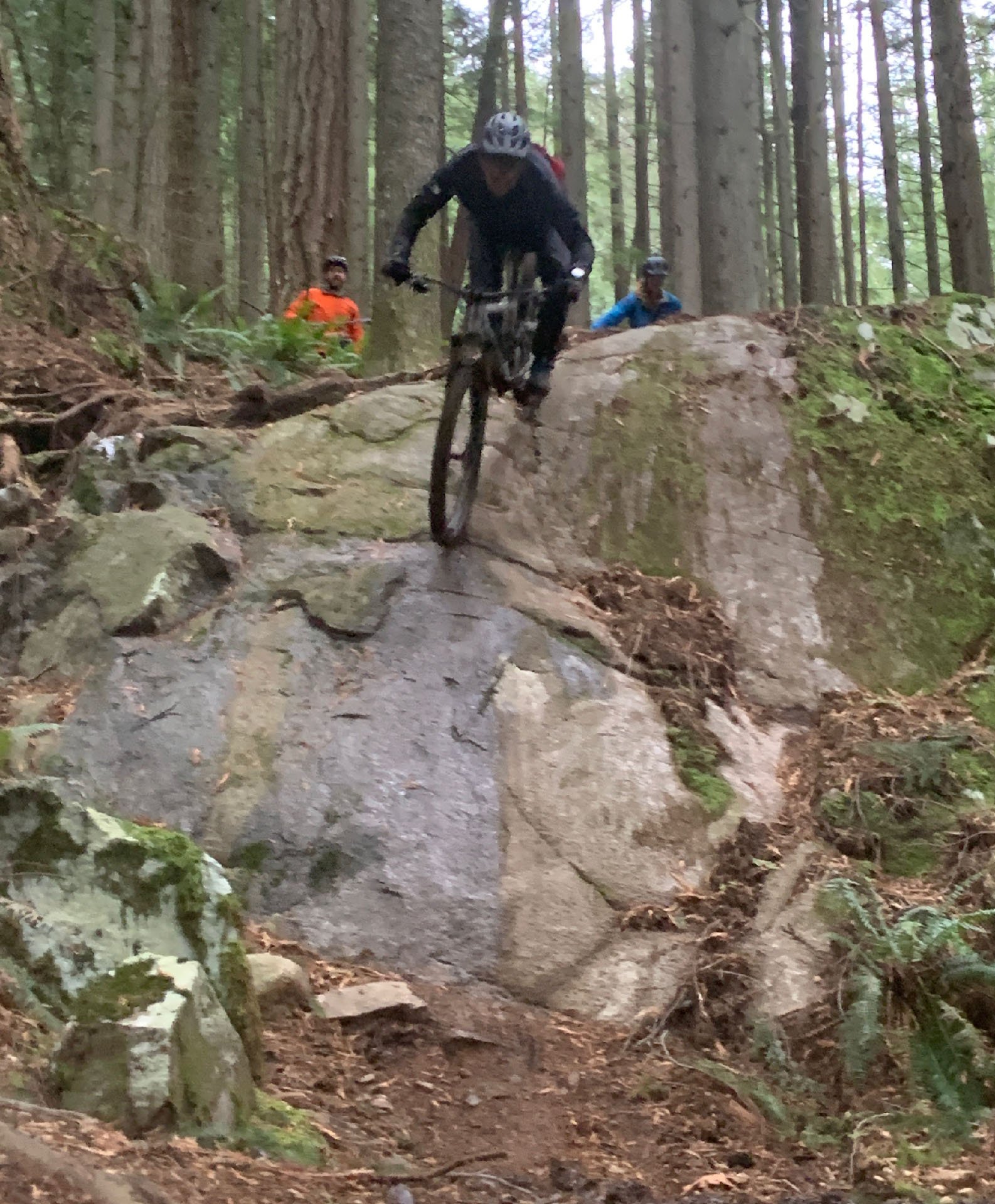
Rockfaces generally look small and steepness almost never translates. This one is both steep and much larger than this images suggests. To make it interesting Pete Roggeman did a two-wheel drift under braking just after this shot was taken. Photo - Clayton Wangbichler
The Way Forward
Tires are expensive and buying rubber that turns out to suck for your riding really bites. Do your research by scouring forums and reviews, ask your riding comrades what they like, and pepper shop rats with questions (and then buy your tires there). Always check the rubber carefully if you are buying a new bike. A few companies are getting better at spec'ing treads lately, but duds are still more common than bullseyes. If you swap out those sickly skins in the shop you may get some cash for the take-offs, but if they are too crappy you may have to settle for a discount on the replacements.
My requirements may be transferrable to your riding if your terrain is steep and challenging and your weather is regularly horrendous (Am I harping? It's already been a long winter). If you live in the desert, I have little to tell you, but I've found that for the most part, aside from hard packed smooth trails, tires like the ones I've described will do a decent job most places.
Height - 6'/183cm (mostly legs)
Weight - 170lbs/77kg
Inseam - 33"/84cm
Ape Index - 0.986
Age - 58
Trail I've been stoked on lately - Sam's Dad's Trail
Bar Width - 760mm
Preferred Reach - 485-500mm (longer with 27.5 wheels than 29)
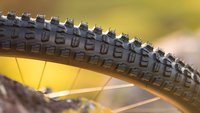
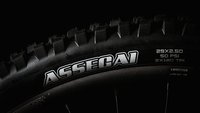
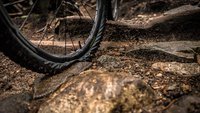
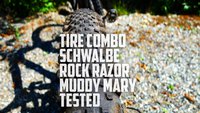







Comments
Deniz Merdano
4 years, 2 months ago
Everybody exists in their own matrix and everybody has their own parameters when judging a tires performance. The variables are so vast that reviewing tires in a comment section is a shot in the dark at best.
The quantifiable characteristics of a certain tire can depend on;
Upfront
Tire pressure, Fork pressure, damper type, service history, frame reach, handlebar width, brake model,
Rear
Tire pressure, Shock pressure, suspension kinematics, suspension service history, rim complience, riding position, etc
North shore riding represents 1% of "mtb experience" shared by the whole wide world. The terrain is different here and it changes dramatically within the 100km radius we ride in daily. Reviewing tires require years of experience on immeasurable combinations of bikes,tires and ground conditions.
Cam has summed it up well and armed you with the information to make your next tire selection a little more, inquisitive.
For me, a DHF 2.5, WTB Verdict 2.5, work really well up front in all conditions.. Rear tire i am less picky, it needs to have tough casing and a paddley design and i am fine..
Reply
Greg Bly
4 years, 2 months ago
I can still get my favorite Maxis tires in 26 inch at MEC! Cam it's funny that you mention that some riders are not picky about tire choice and run higher tire pressures are better riders? No I'm an average rider who believes how I negotiate wet roots is far more crucial than tire compound. I do plenty of wet root diagonal tire slides in the winter . I would not attempt to turn on a wet root with my front tire.
We all have our favorite tire and just like shoes it's a personal choice.
I like the fact that my 26 inch Minions weigh 850 grams and I can't complain about the traction. I think how the carcass responds to your personal choice of tire pressure is most important.
I run my thin wall tires at higher pressure for fast gnar and air down a bit for slab trails. I ride at a moderate speed no racing for this old man.
What's significantly better than a Maxis Minion?
Reply
Perry Schebel
4 years, 2 months ago
have you tried a maxxgrip iteration? the difference a gummy compound makes is huge in our wet conditions.
Reply
Greg Bly
4 years, 2 months ago
I'm running a Max terra 3c DHF in the rear for winter riding. Amazed at how fast the knobs wear! Bontager XR4 team issue up front that never seems to wear out . Is Max terra the same as Max grip?
Reply
ChazzMichaelMichaels
4 years, 2 months ago
Sounds like my riding. No rim protection, high tire pressures, thin sidewalls and reasonable compounds. No flats, no rim strikes, no cuts, and I don't slip.
I can't stand the squirm from lower pressures, feels like the frame or wheel is bending. I wonder if we all ran 2.5s with DD casings at mid twenties whether we'd ever have any issues. We'd all be fitter too!
Reply
Andy Eunson
4 years, 2 months ago
I find the Assegai max terra to feel softer than that designation would indicate. I really like them on the front. Another really good tire is the Michelin Wild Enduro. I think I have the Gum-x version.
Reply
Znarf
4 years, 2 months ago
What are your feelings on low temperates and very soft tire compounds? Some soft compounds harden very significantly below 7deg Celsius. At freezing temperatures this becomes very noticeable. The older Schwalbe Vertstar tires were awful, the ADDIX Soft and Super soft are a lot less awful in the cold.
Maxxis even recommended the dual 60a compound for low temperatures because of this.
Continental Black Chili is said to be good in this regard.
Maxxis 3c Maxxterra works pretty well, but also gets harder and louder when cold. At least in my experience.
It'd be very interesting (and nerdy) to see a systematic test between different compounds and their behavior at cold temperature...
Reply
Vik Banerjee
4 years, 2 months ago
I've ridden Conti Trail Kings [Black Chilli] through most of the last 10 Coastal BC winters and found they had great for traction and volume. Their 2.4" casing is higher volume than the 2.5" Maxxis tires I have tried.
Conti had a 2.6" TK announced and listed on their website....then they quietly pulled the listing down. I was disappointed as I would have loved even a bit more volume.
I'm trying some 2.6" Maxxis tires this winter and will try some of the Schwalbe offerings as well. So far I haven't found a better all round tire than the TK. Just wish they made it bigger.
Reply
andyf
4 years, 2 months ago
Have you tried Conti Der Baron and/or Der Kaiser for comparison?
Reply
Timer
4 years, 2 months ago
The Baron Projekt Apex is available in 2.6. Might well be worth a try if you like the TK.
Reply
Cam McRae
4 years, 2 months ago
I have not noticed that. My most recent experiences on very soft rubber were from e*thirteen on the MOPO versions and I didn't have any problems. In fact they felt great. I didn't stick my fingernail in to check, however.
Are you saying that according to Maxxis, the MaxxGripp is inferior to harder compounds when it gets cold? Clearly auto tire makers get around this because one of the most important differences between summer and winter tires is the soft rubber that continues to conform to the road in cold temperatures.
I began to do some internet sleuthing on this and rabbit holes abound. I haven't found anything specific to bike tires yet.
Reply
mrbrett
4 years, 2 months ago
Not specific to bike tires, but:
If you run sticky tires on a rock crawler, some of them get very slippery in the cold. As far as I understand, the stickiness and slow rebound qualities of the rubber are because there are almost closed cells in the rubber to make it less dense and confirm better to the terrain. These voids closer to the surface that become open can get water trapped in them when it gets wet or freezes (think like a sponge).
The thing on a rock crawler is you can dry the rubber, or at least warm it with wheelspin. Most cyclists aren't capable of that.
Reply
Znarf
4 years, 2 months ago
A friend of mine is working for and with Schwalbe. He is very resourceful and a tinkerer, the most nerdy (in a good way) biker I know. Rides with him turn the uphills into incredibly interesting and controversial discussions on nerdy bike topics. Tire compounds were the thing for many 2018 rides =)
He was closely involved with the development and testing of the new ADDIX compounds a couple seasons back and tested all kinds of attributes and behaviors of different makes and compounds both in the lab and on the bike.
If I sum up his findings (to my best ability) he stated that current soft compounds are massively better in varying temperature ranges than those from ten years ago. Like with car tires, wear and tear (knobs tearing out) will increase massively when you run winter tires in very hot temperatures. Also, summer tires will harden significantly below 7deg C.
Maxxis recommended the 60a tires because of knobs tearing with soft compounds in winter. At the same time, grip will suffer because the compound hardens. A soft tire will feel pretty close to a harder compound below zero. But there seem to be big differences for different compounds. Oil viscosity vs. temperature seems to be a great analogy.
In my experience you can feel those alleged differences at temperatures right around the freezing point of water or slightly above, when you have frozen soil, ice, mud and wet, slimy roots. Your super grippy tires will feel not that grippy at all.
Same trails, same tires, same rider and 5 degrees lower (everything's frozen solid) - you'll have loads of grip. (on BOTH soft and harder compound tires).
All that is pretty theoretical - I'll happily run my Maxxis 3c MaxxTerra or Addix Soft tires front and rear all year round. Swapping tires is a little bit messy with sealant and the 2.5 Shorty WT works pretty okay in almost any condition.
Reply
Shinook
4 years, 2 months ago
While our conditions here aren't as steep as what you have (unless you look off the map...), we're one of the few areas where we can ride year round, often in wet conditions, in forested mountains. I also have a tough time wanting to test tires, because once you find what works, it's hard to motivate yourself to take risk for a change, but you don't find improvements if you don't try, so I suck it up every so often.
I was on WTB for a while, the "new" Vigilante up front does really well in most mixed conditions, but seems to prefer wet, soft dirt over anything else and grips considerably better than any Maxxis tire (Caveat is that I've never run any MaxxGrip tires) I've run. The Trail Boss rear, for what it is, does surprisingly well (grip in the wet is better than the Aggressor, but it wears very quickly) for not super sloppy conditions. The Judge is probably the grippiest rear tire I've used, at the cost of comfort due to the casing.
All that said, I recently got a 2020 Enduro that came with GRID Trail Butchers (2.6f/2.3r), the 2020 variant (these were revised for 2020 with new compounds and casings, the 2019 is different and not easy to distinguish even on the box, you have to check the serial #). I expected to remove them immediately based on prior attempts with Specialized tires, which I found to have weepy casings, tear/pinch flat easily, and unpredictable traction. The surprise to me was that I kept them both on and have been very pleased, even though it's been a pretty wet year for us here, they've done really well on almost everything I've tried them. The only time they start to suffer is on really mucky, wet, muddy conditions where you'd want a mud tire, but even Minions suffer in those conditions.
The 2020 seems to be an entirely different animal than previous models, because I've kept them on and been really pleased with them even in wet conditions. The volume of the 2.3 in the rear is surprisingly large, mine measured 58mm k2k and 61mm at the carcass, being much closer to a 2.4 on 30mm IW rims (EX511). The front 2.6 is not huge for a 2.6 (64 k2k, 65 casing), but it's good enough.
What I've found is that the braking and cornering traction are both really good, I'd say they give up a little bit of performance in soft dirt and mud to the WTB tires I'd previously run, but they continue to surprise me in off camber, wet sections of trail, even in the snow. We had a pretty snowy, wet ride the other day on a notoriously narrow trail here and they continued to surprise me how well they gripped going down despite the conditions. Even on the muddy sections, they held on surprisingly well. I found myself letting off more and more as the ride went on, continuing to be surprised at how well the tires gripped given the conditions, which consisted of a mix of snow, soft dirt, and off camber roots on narrow handlebar width trail.
Reply
Pete Roggeman
4 years, 2 months ago
Shinook, where are you based?
I'm testing a 2020 Enduro with the new Butchers. At first, they were frightening on the Shore, but surprisingly, as temps dropped, they got better. I do not find they hold up to the standards of a DHF/DHR II in typical shore conditions, though - they give up something in grip on roots, especially. Still, I haven't yanked them off, although an Assegai is about to go on the front - whether I replace the back or not I haven't decided because I suspect that as a rear only I'll be happy with it.
Reply
yahs
4 years, 2 months ago
The last pair of butchers I had was the last pair I would every buy. Were way too unpredictable in slippery conditions on the shore.
I do wanna give the e13s a go. Haven't tried them yet.
Reply
Shinook
4 years, 2 months ago
@yahs - I would agree with you prior to the latest models, however apparently the compounds were reworked and softened a fair bit. I don't know specifics, but I know most people here felt the same way about them prior to the current models. Those same folks, myself included, are getting along with the new ones much better.
Reply
Timer
4 years, 2 months ago
I have to admit that this is the first time I hear about new rubber compounds for 2020 Butchers. The only change I am aware of is the grid trail casing.
The 2019 GRID Butchers (and Eliminators, Hillbillys) have a rubber compound that is harder than maxxis Maxxterra but softer than maxxis Dual. The BLK DMND versions have slower rebounding rubber that feels almost but not quite as grippy as Maxxis maxxterra.
I use them and like them as rear tyres for my riding but probably wouldn't chose them for the shore. Definitely not as a front tyre.
Reply
Shinook
4 years, 2 months ago
Specialized isn't exactly forthcoming with information on the updates to their tires. The GRID Trail update is obvious, but details on the updates to compounds and tread patterns are a bit harder to come by.
I read the initial press release for the GRID Trail casings, which indicated compounds were changed for GRID/GRID Trail/BLCK DMND casings. A review on another site I read for the 2020s indicated the same.
To further add to confusion, I know a few years ago (2018 maybe?), Specialized reworked the Butcher tread. I have no idea if the new tread is the same or is different, but the PR and review I read said they were updated again. I don't have any to compare, unfortunately.
I also confirmed all of this with my local shop, who showed me how to differentiate between the year models, as the box is the exact same, so you have to check the year in the serial number. He is another local WNC guy that didn't get along with previous iterations, but has been surprised by the grip of the new tires. Their previous gen tires were also on sale a little while ago.
I think they could do a better job clearing all of this up and make it more evident that they made updates.
yahs
4 years, 2 months ago
I'm sure there will be a review on here for the next gen butcher soon.
Reply
Shinook
4 years, 2 months ago
I'd love to see that.
Tires are one of those things everyone has different experiences with and it's nice to get someone else's perspective, especially living in another part of the world and riding different bikes.
Jerry Willows
4 years, 2 months ago
I have the BLK Diamond casing Eliminator in the rear and have been impressed. No flats either , more than I can say for Maxxis DD
Shinook
4 years, 2 months ago
I'm in Western North Carolina (Pisgah, DuPont, etc). We don't have terrain as steep and, from what I gather, the roots on the trail here are smaller, but grouped together more. We are in the mountains, though, and so we have longer descents and some of them can be fairly technical, but not as much to BC standards. We also don't have a lot of wood features. That said, we do have a lot of wet trails and priority here tends to be more around traction than rolling speed esp on the off camber, rooty/rocky trails, of which there are many.
Like most tires, the pressures you run can give wildly different results. I weigh about 195-200lbs and found that the 2.6 up front does better around 20-21psi, whereas the 2.3 in the rear I run around 24-26psi depending on conditions. Another rider I know here on the same bike/terrain, runs 18-19f/22-23r, but he's about 10-15lbs lighter than I am.
I didn't get along with the Assegai, but I only tried the EXO+ version in MaxxTerra, I haven't run any of the MaxxGrip compound tires. I found it gave up traction quickly in the wet, esp roots, and corners were unpredictable.
Interesting you had issues on roots, though, because that's where they surprised me the most. Even when they were wet, it seems like the Butchers held on well to the off camber, slimy roots we get in spots here, better than Minions have for me, at least.
Reply
Kenny
4 years, 2 months ago
Other than really loose conditions (for example they have a hard time on the " bike park" first section of Dales in its current state, if you've ridden it recently), I really like Bontrager. SE5 front SE4 rear, both in 29x2.6. I estimate the SE casing to be similar or just slightly beefier than EXO+ and the compound to be in between Maxx Terra and Maxx grip, but closer to Maxx grip.
My bike came with assegai wt with exo+/Maxx Terra. They are amazing in the dry but I don't trust them in the wet. They need to make a Maxx grip version that's not a double down or DG casing.
Reply
Pete Roggeman
4 years, 2 months ago
Echo your thoughts on the Bonty options, particularly the SE5 for me. For the $, they're as good as it gets.
Reply
yahs
4 years, 2 months ago
Goodyear Newtons have been great. I usually use Maxxis but got a great deal on the Goodyear's and have no complaints. Solid in all winter conditions.
Reply
Bushpilot
4 years, 2 months ago
I recently put on fresh Magic Marys in Super Gravity casing. I'm using the purple Ultra Soft compound both front and rear in 29x2.35 (with cushcore on both ends). They're definitely heavier and slower to climb but the grip and damp / comfortable ride are mind boggling. While it takes more energy to move them, the extra grip does help with those steep tricky climbs this time of year. I will definitely switch to a faster rolling rear tire when the days (and rides) start to get longer in April / May. But for a winter slip 'n slide season dedicated setup this is the most sure-footed combo I've tried to date. FWIW my winter rides are mainly Fromme and Seymour.
Also, this tire combo can be had for dirt cheap if you're willing to order from overseas and wait a couple weeks.
Reply
william bailey
4 years, 2 months ago
I recently rode Seymour with the Magic Mary SG's but used the soft compound rear and ultrasoft front. I was super impressed. Day was cold and wet and even riding the wood features the tires were amazing. I did find that I ended up being able to run lower than normal pressure (17psi front, 19 rear) and the sidewalls are so strong that there was no wiggle or squirm. I also pinged off some rocks and no issues. I feel like Schwalbe has really upped their game !
Reply
[user profile deleted]
4 years, 2 months ago
This comment has been removed.
Skooks
4 years, 2 months ago
I tend to stick with what I know works. For me, riding on the shore, that's maxxis minions. Dhf 2.5 wt maxgrip in front, and dhr2 2.4 maxterra in the rear. The few times I have tried something else I have been disappointed. Hard to beat the dhf for grip. Everyone in my riding crew has one on the front.
Reply
Cam McRae
4 years, 2 months ago
I used to be the same Skooks. I still love Maxxis but it's great to have more options now. The WTBs, E13s and Minions all have their strengths and all have worked well for me this winter.
Reply
Jenkins5
4 years, 2 months ago
Ditched Maxxis and Schwalbe for e13 last spring and haven’t looked back. LG1 EN Mopo rear (similar construction to Maxxis DD but about 60g lighter) and TRSr Mopo front have been crazy good for everything I ride in the Sea to Sky. Crazy good grip in the wet and dry.
Reply
[user profile deleted]
4 years, 2 months ago
This comment has been removed.
Jenkins5
4 years, 2 months ago
Just order from E13 directly or Backcountry has the TRS MOPO.
https://www.backcountry.com/ethirteen-components-trs-race-a-t-tire-29in?skid=ETR1WUB-BLA-S24IMOP&ti=U2VhcmNoIFJlc3VsdHM6RXRoaXJ0ZWVuIE1PUE86MToxOkV0aGlydGVlbiBNT1BP
Reply
abuxton
4 years, 2 months ago
One tire you don't see mentioned too often is the Maxxis ForeKaster. I've been running the same set in winter-time into my 3rd season now (finally wore out the rear though). Great grip/traction on anything wet and greasy, and even in the snowy conditions we have around here for a few months. They shed mud well, roll reasonably fast, and are relatively light too. I run a set of 2.6s on 35mm rims with good results for a faily non "burly" tire.
Reply
Cam McRae
4 years, 2 months ago
Those don't look to be my cuppa, but in 2.6 I can see it. And they are so light they could be great for Cushcore experiments.
Reply
bananowy
4 years, 2 months ago
I agree that the Magic Mary is best as a front, but any tips or recommendations on what would work well as a rear tyre in combination with it in similar-ish conditions (UK)? My OCD says another Schwalbe (Hans Dampf, or if Nobby Nic was available in soft?), but maybe something else entirely would be the best fit?
Reply
Timer
4 years, 2 months ago
Are you running the Soft or the Super Soft version?
If rolling speed doesn't matter at all you could do what a lot of sponsored Enduro riders do and run a cut Dirty Dan as a rear tyre.
I'm a fan of the Magic Mary (Soft) at the front and rolling speed matters to me. But because I'm not riding on the shore anymore I won't dilute this thread with my favorite rear tires which might or might not be shore worthy.
Reply
bananowy
4 years, 2 months ago
I'm running the soft (orange). Really like it up front.
Thanks for the suggestion with cut Dans. I would say rolling resistance (maybe not so much speed because I'm not fast ;)) matters as on most rides I pedal up (occasionally I go to lift-assisted bike parks). Otherwise maybe simply slapping on 2 Marys would work.
At the risk of getting bashed for diluting the thread I will ask: what are those fav rear tyres of yours?
Reply
Timer
4 years, 2 months ago
My current favorite for pairing with the Mary Soft is a 2.3 Specialized Eliminator BLK DMND. Tough casing, rolls decent and the grip is very good at the rear. Has lots of braking edges which i like. Not the best in mud but thats not my priority.
Before that i had a Vittoria Martello (rolls incredibly well but is fragile), a Hans Dampf Super Gravity (tough, good grip, but rolls badly). Probably better to just run a second Mary instead. And a 2.6 Specialized Butcher Grid (rolls well but less braking grip than the Eliminator). Specialized sizing is a bit weird. The 2.3 x 29" Eli is almost as wide as the 2.6 x 29" Butcher.
Reply
[user profile deleted]
4 years, 2 months ago
This comment has been removed.
kiksy
4 years, 2 months ago
I use double Marys in SG casing when riding in the alps. It really is a great do it all combo. The rolling resistance is pretty painful though, and I prefer something faster like a Hans Dampf or DHF in the rear.
Reply
Cam McRae
4 years, 2 months ago
I haven't found a Schwalbe rear that I like for winter North Shore riding. Like you, I dislike mixing tire brands.
Like you James V., I often find that a tire that works up front will be great in the rear in the wet season and I've wondering about the Magic Mary. This often suits me well because I don't go in for wider front/narrower rear, although what I'm running from WTB (tba) right now fits that description and is working very well. I think I'll double up the front and see how that goes.
Reply
kekoa
4 years, 2 months ago
Yes!!! I too, dislike mixing brands. Sometimes I'm OCD about all the really important stuff. Sigh.
Reply
Please log in to leave a comment.